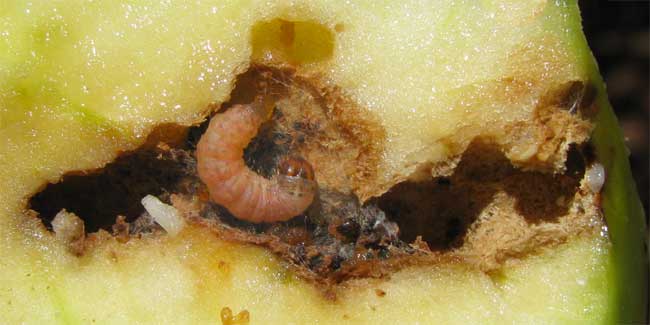Excerpts from Jim Conrad's
Naturalist Newsletter

from the September 13, 2009 Newsletter, issued from the Siskiyou Mountains west of Grants Pass, Oregon:
APPLE WORMS
Like any good citizens, my friends here don't spray their orchard trees with insecticides. Therefore, wormy apples turn up from time to time. "Just cut them out or eat around them," Anita advises, and you'd be amazed how good her applesauce and apple butter is, and how good my own apple-cornbread is, even when the apples I choose are especially wormy "rejects."
The other day I sliced open an apple and found a classic worm snugly in his burrow. You can see him above.
Several "worm" species can infest apples, but this one is the most important. It's the larva of the Codling Moth, CYDIA POMONELLA. Its main field mark is its brown head.
In one of its narrower senses the term "worm" refers to any generally tubular invertebrate of the annelid phylum, such as the earthworm. A more general usage is applied to any animal with a long, cylindrical body and no legs. Neither of these definitions applies to our apple "worm," since it has legs -- six tiny black ones just below the head in the picture, and several "sucker legs" below those. The critter in the picture is the larva of a kind of moth, so actually it's a caterpillar.
Codling Moths can produce 2-3 generations per year 5-8 weeks apart. Once a Codling Moth caterpillar feeds for 3-5 weeks it crawls down the tree and pupates over the winter in thick cocoons under bark or litter on the ground. In the spring adults emerge from the cocoons during flowering time. Females lay eggs on foliage and fruit. Eggs hatch in 1-3 weeks, the larvae chew their way into the fruit core, usually from the blossom end, and then you have what's shown in my picture.
Codling Moths were introduced into North America from Europe.